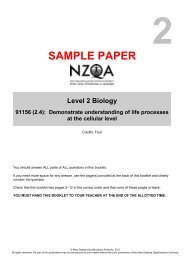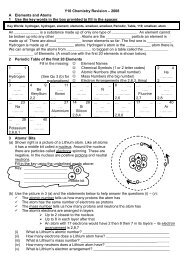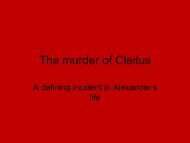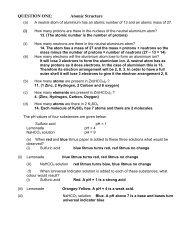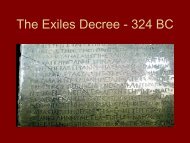Example 1
Example 1
Example 1
Create successful ePaper yourself
Turn your PDF publications into a flip-book with our unique Google optimized e-Paper software.
Internal assessment resource Chemistry 2.7A for Achievement Standard 91167<br />
PAGE FOR TEACHER USE<br />
NZQA<br />
Approved<br />
Internal Assessment Resource<br />
Chemistry Level 2<br />
This resource:<br />
<br />
<br />
<br />
<br />
This resource supports assessment against:<br />
Achievement Standard 91167<br />
Demonstrate understanding of oxidation-reduction<br />
Resource title: Redox rules<br />
3 credits<br />
Clarifies the requirements of the standard<br />
Supports good assessment practice<br />
Should be subjected to the school’s usual assessment quality assurance<br />
process<br />
Should be modified to make the context relevant to students in their school<br />
environment and ensure that submitted evidence is authentic<br />
Date version published by<br />
Ministry of Education<br />
Quality assurance status<br />
Authenticity of evidence<br />
November 2011<br />
To support internal assessment from 2012<br />
These materials have been quality assured by NZQA.<br />
NZQA Approved number: A-A-11-2011-91167-01-5066<br />
Teachers must manage authenticity for any assessment<br />
from a public source, because students may have access<br />
to the assessment schedule or student exemplar material.<br />
Using this assessment resource without modification may<br />
mean that students’ work is not authentic. The teacher<br />
may need to change figures, measurements or data<br />
sources or set a different context or topic to be<br />
investigated or a different text to read or perform.<br />
This resource is copyright © Crown 2011 Page 1 of 6
Internal assessment resource Chemistry 2.7A for Achievement Standard 91167<br />
PAGE FOR TEACHER USE<br />
Internal Assessment Resource<br />
Achievement Standard Chemistry 91167: Demonstrate<br />
understanding of oxidation-reduction<br />
Resource reference: Chemistry 2.7A<br />
Resource title: Redox rules<br />
Credits: 3<br />
Teacher guidelines<br />
The following guidelines are designed to ensure that teachers can carry out valid and<br />
consistent assessment using this internal assessment resource.<br />
Teachers need to be very familiar with the outcome being assessed by the<br />
Achievement Standard Chemistry 91167. The achievement criteria and the<br />
explanatory notes contain information, definitions, and requirements that are crucial<br />
when interpreting the standard and assessing students against it.<br />
Context/setting<br />
This activity requires students to carry out oxidation-reduction reactions and<br />
demonstrate understanding of the reactions.<br />
Oxidants and reductants are used in a variety of ways in modern society.<br />
<br />
<br />
<br />
Hydrogen peroxide is used as a bleach, in glow sticks, hydroponics,<br />
disinfectants, and laundry detergents.<br />
Potassium permanganate is used as a disinfectant for hands and feet, to kill<br />
fungal infections, to treat water, and to make props used in film and television<br />
look old.<br />
Potassium dichromate is used as an ingredient in cement, for cleaning<br />
glassware, tanning leather, wood treatment, and analysing alcohol in the<br />
“breathalyser test”.<br />
Conditions<br />
In part 1, students will gather information by carrying out each test tube reaction,<br />
recording their observations and then interpreting their results. In part 2, students<br />
interpret the observations provided.<br />
You will provide three oxidants and three reductants.<br />
You may choose to change the task by using other oxidants or reductants selected<br />
from explanatory note 4 of the standard.<br />
Prior learning required includes an understanding of oxidation numbers, electron<br />
transfer in reactions, oxidants and reductants, balancing oxidation-reduction<br />
equations, and the ability to relate these to experimental observations.<br />
This resource is copyright © Crown 2011 Page 2 of 6
Internal assessment resource Chemistry 2.7A for Achievement Standard 91167<br />
PAGE FOR TEACHER USE<br />
Resource requirements<br />
<br />
<br />
<br />
<br />
<br />
<br />
Magnesium ribbon<br />
acidified potassium permanganate solution<br />
acidified potassium dichromate solution<br />
dilute hydrochloric acid solution<br />
dilute sodium hydrogen sulfite solution<br />
dilute iron(II) sulfate solution.<br />
It is recommended that you trial the practical experiments before the students to<br />
check all solutions and reactions.<br />
Additional information<br />
None.<br />
This resource is copyright © Crown 2011 Page 3 of 6
Internal assessment resource Chemistry 2.7A for Achievement Standard 91167<br />
PAGE FOR STUDENT USE<br />
Internal Assessment Resource<br />
Achievement Standard Chemistry 91167: Demonstrate<br />
understanding of oxidation-reduction<br />
Resource reference: Chemistry 2.7A<br />
Resource title: Redox rules<br />
Credits: 3<br />
Achievement Achievement with Merit Achievement with<br />
Excellence<br />
Demonstrate understanding<br />
of oxidation-reduction.<br />
Demonstrate in-depth<br />
understanding of oxidationreduction.<br />
Demonstrate comprehensive<br />
understanding of oxidationreduction.<br />
Student instructions<br />
Introduction<br />
In this assessment activity, you are required to explore the reactions of common<br />
oxidants and reductants, interpret experimental results or observations, write<br />
equations to show your understanding of the reactions involved and compare<br />
reactions. In Part 1, you are to carry out test tube reactions and record suitable<br />
observations, in Part 2 the observations are provided.<br />
You will produce a written report showing your understanding of the reactions<br />
involved.<br />
This individual assessment activity that will take place over three to four lessons.<br />
You will be assessed on your understanding of oxidation numbers, electron transfer<br />
in reactions, oxidants and reductants, and balancing oxidation-reduction equations.<br />
You will also be assessed on your ability to relate this understanding to experimental<br />
observations.<br />
Task<br />
Oxidants and reductants are used in a variety of ways in modern society.<br />
<br />
<br />
<br />
Hydrogen peroxide is used as bleach, in glow sticks, hydroponics, disinfectants<br />
and laundry detergents.<br />
Potassium permanganate is used as a disinfectant for hands and feet, to kill<br />
fungal infections, in water treatment and to make props in film and television look<br />
old.<br />
Potassium dichromate is used as an ingredient in cement, for cleaning<br />
glassware, tanning leather, wood treatment and analysing alcohol in the<br />
“breathalyser test”.<br />
This resource is copyright © Crown 2011 Page 4 of 6
Internal assessment resource Chemistry 2.7A for Achievement Standard 91167<br />
PAGE FOR STUDENT USE<br />
Part 1 – Redox reactions<br />
Carry out the following three experiments:<br />
1. Place 3mL of hydrochloric acid in a test tube. Add a small piece of<br />
magnesium metal.<br />
2. Place 2 mL of acidified potassium dichromate solution to a test tube. Add 2<br />
mL of sodium hydrogen sulphite solution.<br />
3. Place 2 mL of acidified potassium permanganate solution to a test tube. Add<br />
2 mL of iron (II) sulphate solution.<br />
For each experiment:<br />
<br />
<br />
<br />
Record your observations.<br />
Explain how the observation for each reaction relates to the species involved.<br />
Write balanced half and overall equations.<br />
Part 2 – Hydrogen peroxide reactions<br />
Hydrogen peroxide can undergo two different reactions.<br />
Observations:<br />
Reaction 1: Acidified hydrogen peroxide will react with potassium iodide solution to<br />
produce a brown solution.<br />
Reaction 2: When non-acidified hydrogen peroxide solution reacts with iodine<br />
solution the brown solution turns colourless and bubbles of a colourless gas appear.<br />
For each reaction above:<br />
<br />
<br />
<br />
Relate the observations to the species involved.<br />
Write balanced half and overall equations.<br />
Compare and contrast these two reactions by identifying the oxidant and<br />
reductant in terms of changes in oxidation number or electron transfer.<br />
This resource is copyright © Crown 2011 Page 5 of 6
Internal assessment resource Chemistry 2.7A for Achievement Standard 91167<br />
PAGE FOR TEACHER USE<br />
Assessment schedule: Chemistry 91167 Redox rules<br />
Evidence/Judgements for Achievement Evidence/Judgements for Achievement with Merit Evidence/Judgements for Achievement<br />
with Excellence<br />
The student shows understanding:<br />
relevant observations are recorded<br />
For example:<br />
Bubbles/fizzing, metal dissolves<br />
Orange solution turns blue/green<br />
Purple solution turns pale yellow-brown<br />
key reactant and product species are correctly<br />
identified for three reactions<br />
For example:<br />
Mg + H + Mg 2+ + H 2<br />
Cr 2 O 2- -<br />
7 + HSO 3 Cr 3+ 2-<br />
+ SO 4<br />
MnO - 4 + Fe 2+ Mn 2+ + Fe 3+<br />
H 2 O 2 + I - I 2 + H 2 O<br />
an oxidant or reductant is identified without<br />
linking to oxidation number or electron transfer<br />
for one reaction.<br />
For example:<br />
In the first reaction H 2 O 2 is the oxidant.<br />
The student shows in-depth understanding:<br />
balanced overall equations are written for three<br />
reactions<br />
For example:<br />
Mg + 2H + Mg 2+ + H 2<br />
Cr 2 O 2- 7 +3HSO - 3 +5H + 2Cr 3+ +3SO 2- 4 +4H 2 O<br />
MnO - 4 + 8H + + 5Fe 2+ Mn 2+ + 5Fe 3+ + 4H 2 O<br />
H 2 O 2 + 2H + + 2I - I 2 + 2H 2 O<br />
observations are linked to species for three reactions<br />
For example:<br />
Metal dissolves because Mg turns to Mg 2+ .<br />
Bubbles occur because H + turns to H 2 .<br />
The solution turns from orange to green because<br />
Cr 2 O 2- 7 is orange and Cr 3+ -<br />
is blue/green. HSO 3<br />
and SO 2- 4 are colourless.<br />
MnO - 4 is purple, Fe 2+ is pale green. The resulting<br />
solution is pale yellow-brown due to the formation<br />
of Fe 3+ . Mn 2+ is colourless.<br />
Brown colour forms due to the formation of I2. All<br />
other species are colourless.<br />
oxidants and reductants are identified in terms of<br />
oxidation number or electron transfer for one reaction.<br />
For example:<br />
H 2 O 2 is the oxidant because each oxygen gains<br />
one electron or oxidation number goes from -1 to -<br />
2 in H 2 O.<br />
I - is the reductant because it loses one electron or<br />
oxidation number goes from -1 to 0.<br />
The student shows comprehensive<br />
understanding:<br />
balanced overall equations are<br />
consistently written with no errors<br />
observations are linked to species for<br />
all reactions<br />
oxidants and reductants are identified<br />
in terms of oxidation number or<br />
electron transfer for both reactions.<br />
For example:<br />
When acidified H 2 O 2 reacts, it is the<br />
oxidant because each oxygen gains<br />
one electron or oxidation number goes<br />
from -1 to -2 in H 2 O.<br />
I - is the reductant because it loses one<br />
electron or oxidation number goes<br />
from -1 to 0.<br />
When non-acidified H 2 O 2 reacts it is<br />
the reductant because each oxygen<br />
loses one electron or oxidation<br />
number goes from -1 to 0 in O 2 . I 2 is<br />
the oxidant because it gains one<br />
electron or oxidation number goes<br />
from 0 to -1.<br />
Final grades will be decided using professional judgement based on a holistic examination of the evidence provided against the criteria in the<br />
Achievement Standard.<br />
This resource is copyright © Crown 2011 Page 6 of 6



